Rise of integrated community farms
Environmentalism continues to increase in popularity and people are still feeling confined in their homes due to the pandemic. Citizens have taken up gardening as a solution to both.
This trend began when Rancho Mission Viejo started to sell homes in 2014. Rancho Mission Viejo became one of the first cities to make community farms as a unique neighborhood characteristic.
‘Agrihood’ farm-to-table initiatives have gained prominence in south Orange County cities such as Rancho Mission Viejo, in which three farms are currently open and more are in the works for upcoming projects, and even across the country as the Urban Land Institute has located more than 90 neighborhoods with similar gardens.
These community farms are incorporated within central areas accessible to all of the residents, so it contains a communal aspect. This system advocates for social engagements and therefore activities. This system includes farming workshops, family days, monthly donations to food banks, and resident farmer potlucks (now done virtually).
Officials are now converting one of Aliso Viejo’s last available undeveloped sites into a community farming area, which also commemorates Orange County’s agricultural history with the inclusion of landmarks.
This ranch project would further establish convenient and sustainable urban agricultural opportunities through aquaponics. In addition, it would increase the amount of recreational areas in south Orange County.
Thus far, the citizens have expressed their contentment for the environmental and collective benefits through the addition of these farms. Namely, residents have already donated a significant amount of the goods produced in the current farms to local food banks, which are in great demand.
Other advantages include the cooling of the atmosphere and reducing what is known as the ‘heat island effect’ since this vegetation may reflect up to 20 to 25 percent of sun radiation. In addition, given that a meal travels roughly 13,000 miles in the United States before it reaches a customers plate. So, eating local foods reduces carbon dioxide emissions and fuel consumption.


